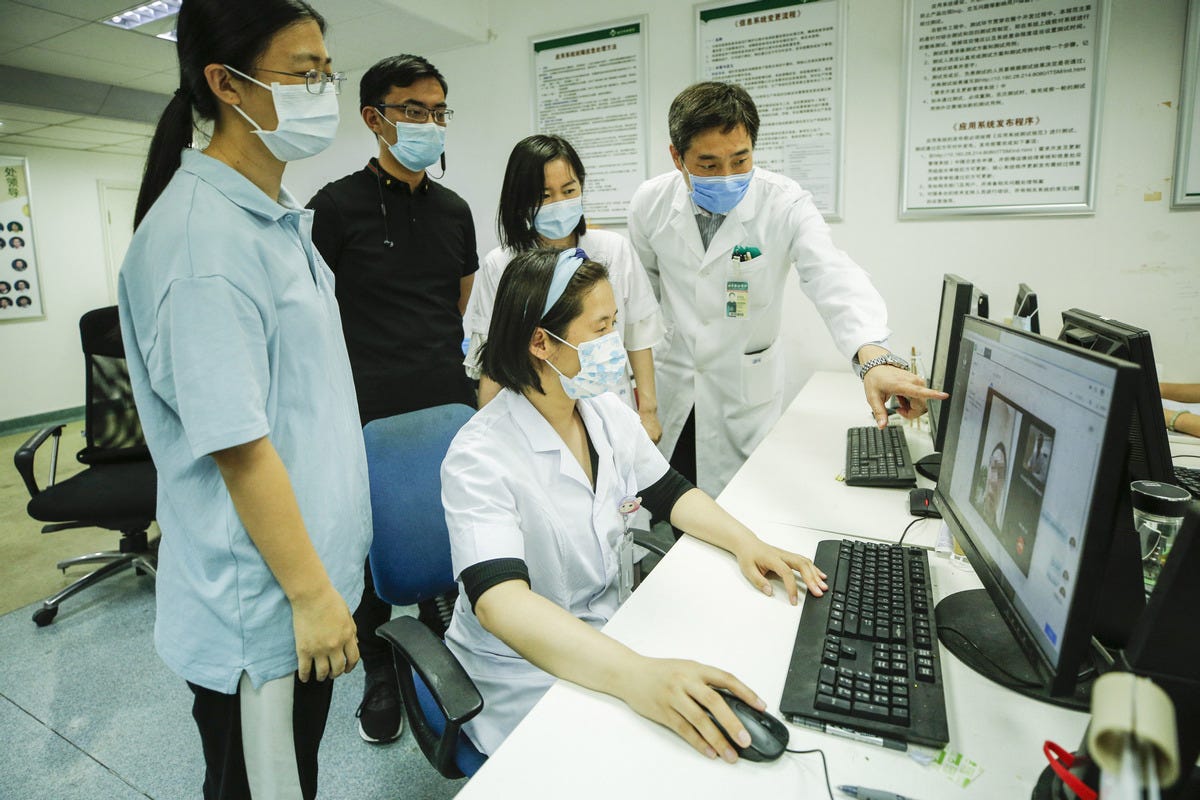🙅🏻♂️Beijing City Bans AI-Generated Prescription; What Big Tech Earnings Say About AI; Rise of AI in China's Small Cities
Weekly China AI News from August 21 to August 27
Dear readers, in this issue, I will discuss the Beijing city’s new draft regulation that bans AI-generated prescriptions in telemedicine. Chinese tech giants have reported their latest quarterly financial results, and let’s recap what they say about AI. Young Chinese people in lower-tier cities actively adopt LLMs like ChatGPT and ERNIE Bot to improve their productivity. Plus, if you like Japanese anime and AI, you must check out Chat-Haruhi-Suzumiya, an LLM that imitates the tone, personality, and storylines of characters like Haruhi Suzumiya.
Beijing Prohibits AI-Generated Prescriptions in Telemedicine
What’s new: The Beijing municipal government’s Health Commission has released new draft regulations governing telemedicine, “strictly prohibiting” the use of AI for generating medical prescriptions. The regulations also mandate real-name verification for healthcare providers involved in telemedicine.
How it works: Under the new rules, medical institutions offering telemedicine services, or “online medical diagnosis and treatment” in literal translation, must perform real-name authentication for healthcare personnel to ensure they have valid qualifications.
The regulations also emphasize the strict management of medications. Prescriptions must be written by the physician and approved by a pharmacist before being activated. AI-generated prescriptions are explicitly banned, and medications must only be dispensed, adjusted, and used based on a valid physician’s prescription.
Why it matters: The regulations reflect a trend of balancing the adoption of technology in healthcare with the need to ensure patient safety and uphold medical ethics. The telemedicine industry in China has seen rapid growth in recent years, with the number of online medical users reaching 363 million as of December 2022.
What Chinese Big Tech Earnings Say About AI
What’s new: The earnings season is nearly over, so let’s take a look at what Chinese tech giants like Alibaba, Tencent, Baidu, and JD.com have said about AI in their recent earnings reports over the past two weeks.
Alibaba reported a strong earnings beat for its first quarter of 2024, with revenue up 14% year-over-year. CEO Daniel Zhang stated that Alibaba Cloud has seen strong demand for AI on its cloud infrastructure, although this was only partially met due to near-term global supply chain constraints.
Despite missing revenue estimates, Tencent delivered some upbeat news regarding its development of foundational models. President Martin Lau announced that the company plans to unveil an AI model later this year that will be “among the top leading foundational models produced in China.”
JD.com reported solid second-quarter results, with earnings and sales up 33% and 8% year-over-year, respectively. No AI updates were disclosed in the earnings, though.
Baidu posted better-than-expected revenue, up 15% YoY, and net income, up 44% YoY, for Q2 2023. CEO Robin Li shared that Baidu will launch the ERNIE 4.0 foundation model by the end of 2023. The ERNIE Bot has been enhancing Baidu Search and the Baidu App by answering more complex questions.
NetEase missed revenue estimates but exceeded expectations in earnings. CEO William Ding said the company has adopted AI in programming and graphic design, shifting the game-designing mindset from “game plus AI” to “AI plus games.”
Meituan reported strong revenue growth, up 33.4% YoY, and returned to profitability in Q2, although the Q3 outlook is weaker than expected. While the company’s management barely discussed AI in earnings calls, Meituan has invested heavily in Chinese AI startups, including the acquisition of Lightyear and investment in Zhipu AI.
The Rise of LLM in China’s Lower-Tier Cities
What’s new: The rapid development of LLMs like ChatGPT has sparked great interest among young people in lower-tier cities in China, a Chinese media outlet reported. These young people are exploring how to use AI tools to improve efficiency and make money.
Meet Hao, a designer at a small e-commerce company in Linyi, a small city in Shandong Province. He is embracing Midjourney in his daily creation. In just 2 hours, Hao created a collection of 60 product images for a furniture client—a task that usually takes 5-7 days. When the task involves traditional Chinese elements, like dragon boats, Hao will turn to Chinese AI models like Baidu’s Wenxin Yige.
Others, like Fan, a programmer in rural Anhui, are turning to ChatGPT to write short stories for children to be published on Amazon. “The AI gives me the basic story structure, which I then refine,” he explains. His book is already earning royalties.
University student Qianqian is applying for a university in Britain. She uses ChatGPT daily to compose polished rental and application emails. Some of her classmates are even using ChatGPT or ERNIE Bot as search engines.
However, limitations of LLMs still exist. For example, AI art can seem disjointed across scenes. ChatGPT’s academic citations are imaginary. But these youths aren't deterred. “We need to learn how to properly use AI as a tool, not be led by it blindly.”
Weekly News Roundup
👑 Hong Kong-based television broadcasting company TVB announced its first AI MC, Chen Wanyan (Evelyn), will debut at the 2023 Miss Hong Kong finals on the 27th. She was created by synthesizing footage of past Miss Hong Kong winners from the last 50 years.
🤖 Alibaba Cloud open-sourced a large visual language model called Qwen-VL. Built on Qwen-7B, the new model can accept both text and image inputs.
🔢 TAL Education launched MathGPT, a large-scale model specializing in math problem-solving and teaching algorithms, for beta testing. Users can now register for a free trial on the official website, www.mathgpt.com.
🏭 China’s Ministry of Industry and Information Technology and other ministries jointly issued a new industry standardization plan for 2023-2035. The plan focuses on emerging industries like next-gen IT, new energy, civil aviation, and future industries such as the metaverse, humanoid robots, and generative AI.
🔌 Alibaba’s semiconductor company Pingtouge released its first self-developed RISC-V AI platform, boasting an over 80% performance improvement compared to traditional solutions. The platform is capable of running more than 170 AI models.
💰 DP Technology has secured over 700 million RMB in a new funding round from investors, including Zhongyuan Capital and Evergreen Scitech Delta. The company is focused on applying “AI for Science” in various research fields like biomedicine, energy, materials, and information science.
📱 Kuaishou rolled out its LLM, KwaiYii, for beta testing. The 13B version of KwaiYii ranked first in the latest CMMLU Chinese language benchmark for both five-shot and zero-shot categories.
🚗 Baidu has expanded its autonomous driving services to airport transportation in Wuhan, becoming the first in China to offer driverless rides to and from airports.
📈 WeRide.ai has received approval from the China Securities Regulatory Commission for its overseas IPO filing, clearing the way for the company to go public abroad.
Trending Research
ChatHaruhi: Reviving Anime Character in Reality via Large Language Model
Role-playing chatbots built on large language models have drawn interest, but better techniques are needed to enable mimicking specific fictional characters. We propose an algorithm that controls language models via an improved prompt and memories of the character extracted from scripts. We construct ChatHaruhi, a dataset covering 32 Chinese/English TV/anime characters with over 54k simulated dialogues. Both automatic and human evaluations show our approach improves role-playing ability over baselines. Code and data are available at https://github.com/LC1332/Chat- Haruhi-Suzumiya.
DragNUWA: Fine-grained Control in Video Generation by Integrating Text, Image, and Trajectory
Existing controllable video generation methods lack fine-grained open-domain control. We propose DragNUWA, a diffusion model enabling control via text, images, and trajectories. It introduces a Trajectory Sampler for open-domain control, Multiscale Fusion for multi-granularity control, and Adaptive Training for trajectory consistency. Experiments show DragNUWA’s superior fine-grained control for open-domain video generation. (Affiliations: University of Science and Technology of China, Microsoft Research Asia, Peking University)
Multimodal biomedical foundation model BioMedGPT
BioMedGPT-10B is the first commercial-friendly multimodal biomedical foundation model jointly released by PharMolix and the Institute of AI Industry Research (AIR). It aligns the language of life (molecular structures and protein sequences) with human natural language, performing on par with human experts on biomedical QA benchmarks and demonstrating powerful performance in cross-modal molecule and protein question-answering tasks. BioMedGPT-LM-7B is the first commercial-friendly generative foundation model tailored for biomedicine based on Llama-2. (Affiliations: PharMolix, Tsinghua University)








